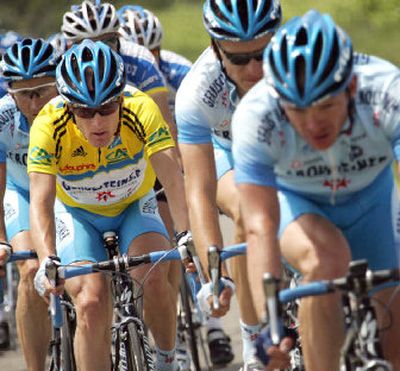Future still bright

PARIS – Tom Danielson was a mountain biker. Now he’s a road racer, a member of the U.S. Discovery Channel team, a teammate of six-time Tour de France winner Lance Armstrong and grateful to America’s iconic bike racer.
“Shortly after I switched to road racing,” Danielson said, “I got a chance to meet Lance. He sat down and talked to me for a long time, told me he thought I had potential and pretty much opened up my eyes to what I can do. It was such an honor. It kind of changed my life.”
Armstrong begins the chase for his seventh consecutive Tour de France victory Saturday in Fromentine, near the Atlantic coast. This will be an attempt at record-padding for Armstrong, 33, who last summer became the first man to win six straight Tours.
Since the Texan, whose story is punctuated not only with record-setting statistics but also with his heartwarming triumph over cancer, has announced the 2005 Tour will be his final competitive race, obvious questions loom about the future of U.S. cycling.
Will American interest wane in this foreign-dominated sport, and in a race that meanders over 22 days and covers more than 2,000 miles of unfamiliar territory? – Is cycling in the U.S. nothing more than a periodic phenomenon reliant on singular American champions who pop up once every couple of decades?
Some nouveau U.S. fans have no idea that Armstrong isn’t the first American to win the Tour; Greg LeMond won three Tours in the late 1980s.
But when LeMond retired, the Tour de France was largely forgotten by Americans until Armstrong began his streak in 1999.
The U.S. cycling cupboard is a little fuller now, with Danielson and others.
It’s even possible that were Armstrong’s streak to end this year it might be another American who beats him.
Levi Leipheimer, a 31-year-old from Montana who will lead German team Gerolsteiner, has twice finished in the top 10 at the Tour and was a strong third at the Dauphine Libere, a key Tour prep race, last month.
Floyd Landis, 29, has taken over leadership of the Swiss team, Phonak, assuming the role previously held by Tyler Hamilton, another American, before he failed a blood doping test last summer.
Bobby Julich, 33, became the first American to win the historic Paris-Nice road race earlier this year.
But it is the next generation of riders who will be watched more closely.
Danielson, 27, climbed to victory at the Tour de Georgia last April in the biggest race on American soil. Armstrong was riding in support of Danielson on the last day.
Danielson is not on Discovery’s Tour de France team because he is recovering from a back injury, but he is expected to be a key rider at the Spanish Vuelta later this summer.
David Zabriskie, 26, who won a stage at the Giro d’Italia this spring while riding for Danish team CSC, and 21-year-old amateur Tyler Farrar, along with Danielson, have been tabbed as possible future American Tour de France stars.
Jim Ochowicz, president of USA Cycling and one of the men responsible for nurturing the group of American cyclists that includes Armstrong, Julich, Leipheimer, George Hincapie and Hamilton, who have all made marks on international cycling, thinks Armstrong has made cycling a sport that will matter in the United States for a long time.
“Lance has given cycling legs,” Ochowicz said. “Before Lance, it was like a spider. Now it’s like a centipede, legs everywhere. When Lance is gone next year, the sport will still have a lot of life left in it. The momentum will take a long time to slow down and in the meantime all of us within the sport of cycling will need to find talented younger athletes to take up Lance’s cape.”
Ochowicz believes that because of Armstrong some general sports fans can now use terms such as “peloton” in a sentence that makes sense.
“Cycling interest has expanded beyond the Tour de France,” Ochowicz said. “There are all sorts of interesting races that have gotten more publicity. That interest is not immediately going to go away when Lance leaves. Will some of the coverage pull back? Sure. But there will be a U.S. team and there is a strong group of U.S. athletes still in the picture.”
Gerard Bisceglia, chief executive officer of USA Cycling, said that organization has seen a 30 percent increase in the number of cyclists it has registered in the last three years.
Bisceglia said that while LeMond’s accomplishments were amazing, “Greg was an American expatriate riding for a foreign team. Greg was an American individual who conquered a foreign sport. Lance brought the sport back to our shores.”
At junior races around the country, Bisceglia said, saturation points are continually reached in the number of riders who can compete. “Now it’s the obligation of USA Cycling to maintain what Lance has started,” he said.
If there is cause for concern it might be that Discovery Channel, the first-year sponsor of what used to be the United States Postal Service team, is grooming a young Ukrainian rider, 25-year-old Yaroslav Popovych, as Armstrong’s immediate successor.
Danielson is still making the transition from mountain biking to road racing and isn’t expected to be a Tour threat for another year or two. Landis, who had been seen as the likely successor to Armstrong, left the U.S. team suddenly last season for a bigger contract and more immediate responsibility at Phonak.